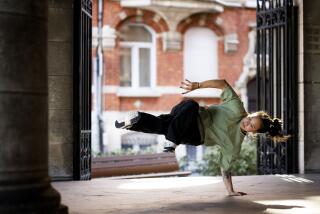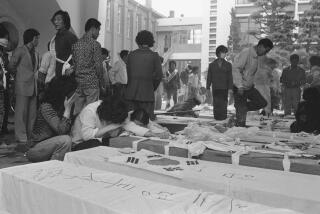Gen. Choi Hong-hi , 83; Pioneered Taekwondo
- Share via
Choi Hong-hi, the Korean general who developed the martial art of taekwondo more than 50 years ago and watched it attain worldwide popularity, has died. He was 83.
Choi, who became a Canadian citizen in 1977, was a longtime resident of the province of Ontario. He returned to the Korean peninsula weeks before his death from stomach cancer in Pyongyang, North Korea, on June 15.
Taking elements from the Korean art of foot fighting, called taek kyon, and Japanese karate, the self-defense art of taekwondo stresses physical and mental strength, discipline and humility.
It is now practiced in 150 countries around the globe by as many as 50 million students. In the United States alone, there are several million practitioners and family participation is growing. A demonstration sport in the 1988, 1992 and 1996 Olympic Games, it was a medal sport in the 2000 games in Sydney.
The man who developed the sport and gave it its name was born in 1918 in what is now North Korea. Expelled from school for leading a protest against the occupying Japanese, he was sent to study calligraphy with a tutor who wound up teaching him taek kyon.
In the late 1930s, he continued his education in Japan, where he began to study karate and eventually attained a second-degree black belt. While in Tokyo in 1942, he and a number of other Korean students were conscripted into the Japanese army. Returned to Korea to serve, Choi and several comrades tried unsuccessfully to escape and join the opposition Korean Liberation Army. Imprisoned on charges of treason and sentenced to die, Choi was freed when Korea was liberated just days before the sentence was to have been carried out.
While in prison, Choi began working on the foundations of taekwondo.
After the war, he was one of the founders of the South Korean army. Sent to the U.S. for training in the late 1940s, he taught the basics of taekwondo to American servicemen at Ft. Riley, Kan., and Ft. Benning, Ga.
He returned to Korea at the outbreak of the war there and established an officer training program. Later he created a crack infantry division, which eventually would produce instructors in taekwondo for the entire South Korean army.
He named the discipline in 1955 by joining tae (which means foot fighting or kicking), kwon (to strike with a fist) and do (art). The International Tae Kwon Do Federation was founded in the mid-1960s and developed local associations around the world.
In the early 1960s, Choi was a supporter of the military coup that installed Gen. Park Chung-hee as president of South Korea. In 1962, Choi left the army to serve as South Korean ambassador to Malaysia.
He returned to Seoul in the mid-1960s and continued to advance taekwondo, but left in the early 1970s because of the increasingly repressive political climate under Park.
From his exile home in Canada, Choi taught taekwondo in countries around the world, including North Korea. He also wrote “The Tae Kwon Do Encyclopedia,” which has become the standard reference work for the martial art.
Choi’s survivors include his wife, Choi Joon-hee; daughters, Sunny and Meeyun; a son, Jung-hwa; and several grandchildren.
More to Read
Sign up for Essential California
The most important California stories and recommendations in your inbox every morning.
You may occasionally receive promotional content from the Los Angeles Times.













